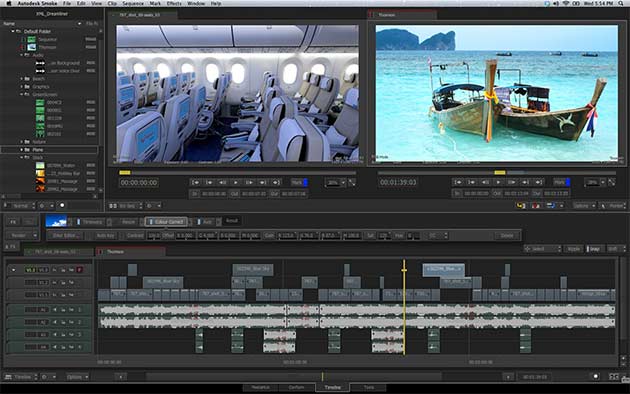Reimagined Software Combines Editing with High-End Compositing
Following more than six months of pre-release trials, in which the company sought input from working editors on sweeping changes to one of its flagship software programs, Autodesk said it started shipping Smoke 2013 this morning. The new version of Smoke includes an overhauled user interface that combines editorial timelines with robust, node-based effects and compositing tools in the same environment.
The price, too, is new. Smoke 2013 sells for $3495 — actually, it's $2796 if you buy it before January 25 — compared to the $15,000 price tag of older versions. It's no longer anything like a heavy-iron system, either — this version of Smoke runs on the latest iMacs and MacBook Pros. It's a serious challenge to existing editing and VFX workflows.
"What we're aiming for is the systems that everybody uses," said Autodesk's Marc Hamaker, Senior Product Marketing Manager for Creative Finishing, at a press briefing in New York last week. "It's not a special system configuration that's designed to sit in a room that's locked up as a 'Smoke suite.'" He noted that previous versions of Smoke used DPX files as an intermediate format, while Smoke 2013 works with Apple ProRes. Turnkey Smoke systems used to be delivered with fibre-channel connectivity, but users of Smoke 2013 will likely be connected to storage via Thunderbolt.
Smoke's new node-based ConnectFX interface.
The new software features a familiar timeline interface, and editors have easy access to range-based color-correction, keying, masking tools, and even 3D titles, effects, and motion graphics. The power of the interface is unlocked when an editor uses the Connect FX (CFX) feature, which introduces a node-based compositing interface that remains tightly integrated with the original timeline.
Asked if Autodesk saw editors using Smoke as an NLE replacement, rather than as a supplement, Hamaker said it would probably depend on each individual project. But he made it clear that Autodesk isn't expecting anyone to throw out existing editing systems just to make room for Smoke. "We had to make sure conform workflows stayed in place," he said. "We have a workflow with every NLE out there, including Final Cut Pro X."
But he also said Autodesk's marketing strategy should make its ambitions clear. "We think the price makes a statement about how aggressive we are about bringing new people into the family, so to speak."
Autodesk might have been a hair too aggressive, missing the scheduled September launch date after announcing Smoke 2013 at NAB. But the trial period was extended to collect more feedback and improve the user experience before shipping. In fact, Autodesk released six different trial versions of Smoke 2013, implementing such fixes as tweaks to the placement of UI elements, allowing the FX pipeline panel to be collapsed in order to preserve screen space for the editorial timeline interface, implementing drag-and-drop from the source viewer, and bringing back the old desktop paint tool to live alongside a newer one that Autodesk originally thought would supersede it.
Working in 3D space.
And there's more to come, of course. Hamaker said Smoke users can expect "pretty aggressive updating from Autodesk," with new features being added regularly, rather than saved up for massive annual releases.
For more on Smoke, visit the Autodesk Smoke Learning Channel or the Autodesk Area Discussion Forums. If your interest is piqued, download a 30-day free trial. You might want to hurry — Autodesk hasn't set an expiration date for the free 30-day trial offer, but the company told us more restrictions will be placed on trial downloads at some point in 2013.
Crafts: Editing VFX/Animation
Sections: Technology
Topics: New product autodesk compositing headlines nle smoke 2013 VFX
Did you enjoy this article? Sign up to receive the StudioDaily Fix eletter containing the latest stories, including news, videos, interviews, reviews and more.













Leave a Reply